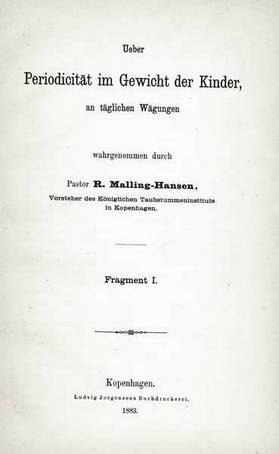The Argos Reflector 1885.01.22.
[1]Research, transcription and comments by Jorgen Malling Christensen.
Illustrations by Sverre Avnskog.
The article refers to Malling-Hansen’s Fragment I from 1883. In August 1884 Malling-Hansen had the singular opportunity to address the participants of the international medical congress in Copenhagen and on that occasion gave a lecture about his research and distributed his Fragment II (in German). Many American medical doctors and scientists attended the conference.
The article in The Argos Reflector was borrowed from Chicago Times, and the same article also appeared in at least 6 other American newspapers: 1) Springfield Daily Republic (Springfield, Ohio) on Jan 22, 1885; 2)The Daily Register (Washington, Kansas) on Jan 23, 1885; 3) Galena Weekly Republican (Galena, Texas) on Jan 24, 1885; 4) The Times and Democrat (Orangeburg, South Carolina on March 5, 1885; 5) The Clay Democrat (Clay Center, Kansas) on April 30, 1885; and 6) The Marengo News (Demopolis, Alabama) on May2, 1885.
THE WEIGHT OF CHILDREN
------
How it Varies from Day to Day –
Periods of Increase and Decrease.
Pastor Malling-Hansen, the director of the royal Deaf and Dumb Asylum in Copenhagen, has published an interesting pamphlet[2] on “the Periodicity of the Weight of Children”.
His observations, obtained by the daily weighing of the children under his care, are very interesting. According to his evidence the weight of children differs so largely from day to day that no trustworthy result can be obtained from weighing at long intervals. A child may be two pounds heavier at night than in the morning and may be one and a half pound lighter in the morning than the night before.
Eating seems to have more influence on weight than exercise, bathing or occupation. The ultimate increase in weight, corresponding to increase in growth, does not go on regularly throughout the year. There is a period of stoppage in the increase of weight with corresponding loss from the beginning of May till past the middle of June, in which time the loss of weight may exceed double the average ultimate gain. During August, September and October there is a very steady period of increase in weight, sometimes rising to five times more than the average increase.
During the rest of the year the weight varies from less to more around the average figure of increase. During the summer holidays the increase in weight is twice the average, and in September and October even thrice. Besides the serious period of loss from May to July, there are at other times frequent sudden stoppages in the increase of weight, sometimes followed by actual loss.
These hindrances, lasting from six to fourteen days, are not made up for by extra periods of increase, and seem to indicate real damage, so that the actual increase of weight seems to take place during about the fifth part of the year, while the remaining time is occupied with loss and its replacement. There is a decided correspondence between the vacillation of temperature and accompanying vacillations in the weight of the child – increase of warmth and of weight and decrease of warmth and of weight go hand in hand.
A decrease of two degrees of warmth in the temperature of the five days is accompanied by a nine fold decrease in the weight of a child, and three degrees more warmth by a thirteen fold increase in weight. The hindrance and loss of weight that accompany a decrease in the warmth of the temperature may go on even after the temperature has begun to rise, as if the loss depended on sickliness induced by the colder temperature.
A year that has had most changes of temperature is far more unfavourable to the normal increase of weight in a child than a more steady year, and a series of such unfavourable years will for many following years result in less strong children. The reason of the great period of loss from May to July, and the rapid increase during the autumn months, do not seem to depend on the conditions of warmth.
The increase of weight in the children experimented on was always greater during the period when the moon was receding from the earth, and less during the period when the moon was approaching the earth. During the former period the children increased in weight twice as much as during the latter period.
Pastor Malling-Hansen’s inquiries are considered so important that the Danish Government and the ‘Carlsbergfond’ have granted sums of money for the continuance and extension of such experiments. –
Chicago Times.
[1] JMC: Published in the city of Argos, Indiana.
[2] JMC: This refers to Malling-Hansen’s publication in 1883 of his ‘Fragment I’, appearing as a separate pamphlet of the Nordic magazine “Nordisk Tidsskrift for Fængselsvæsen”. The complete text (in Danish) is on our site.

